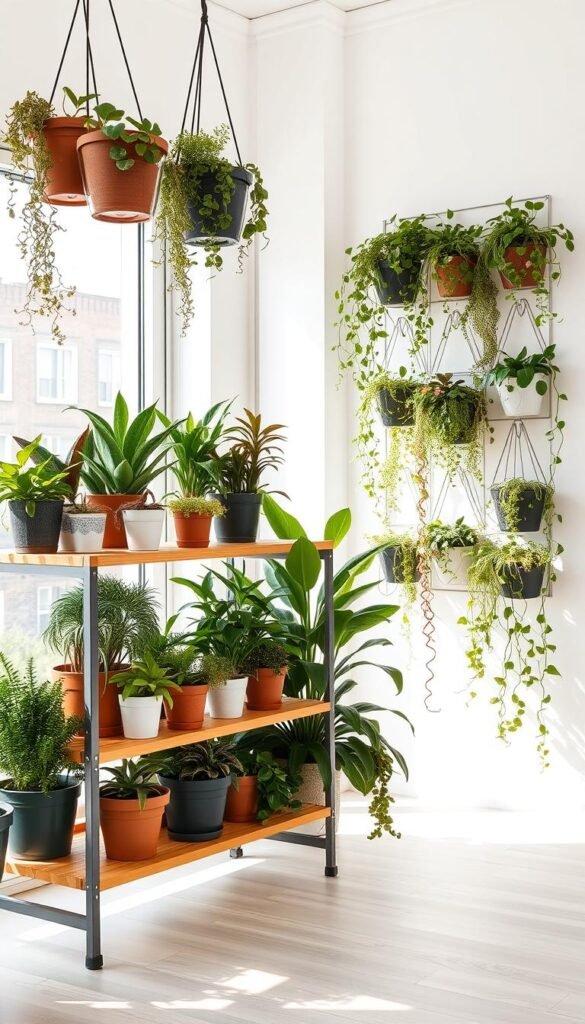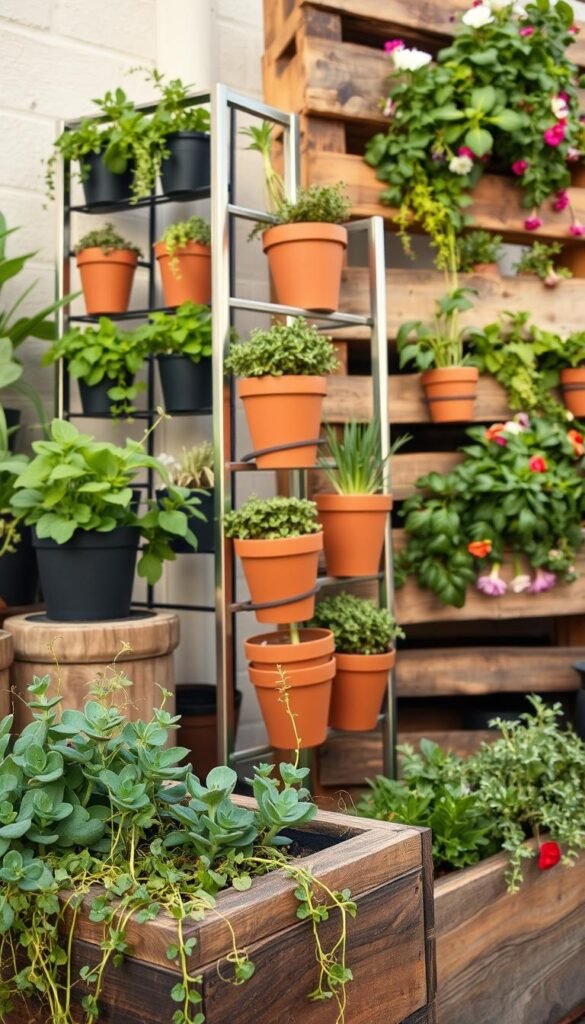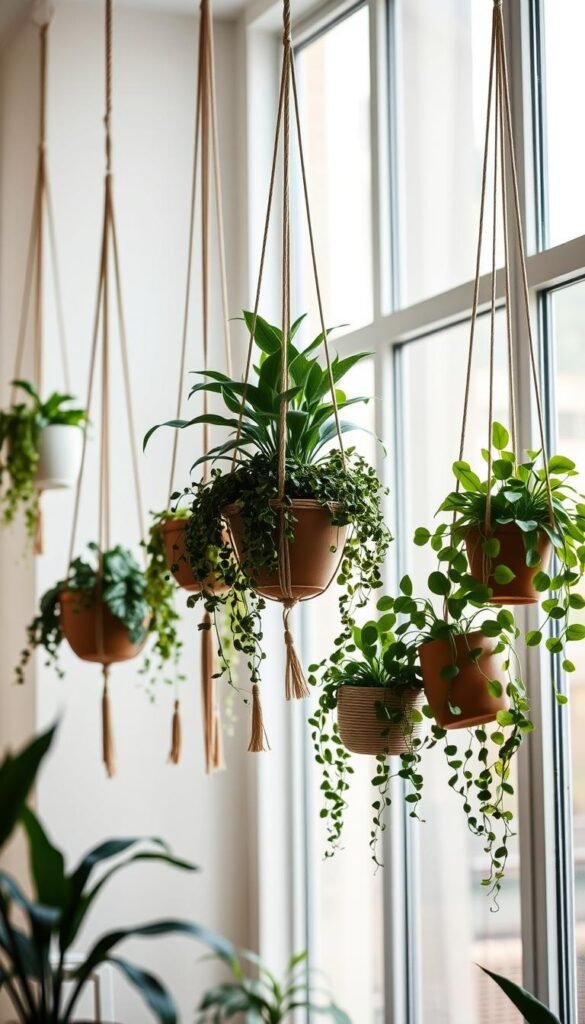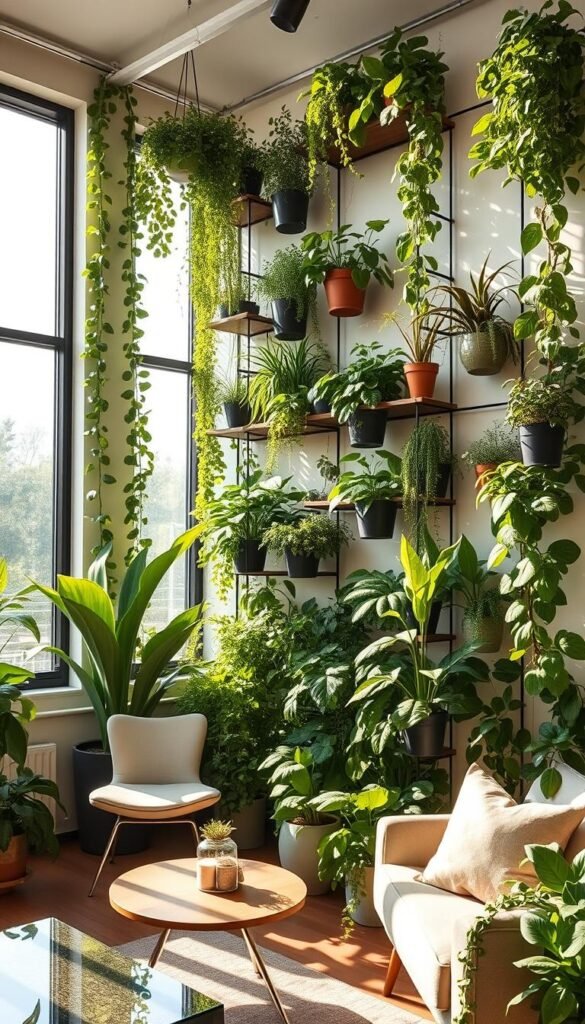Living in tight quarters doesn’t mean giving up fresh herbs or vibrant greenery. Vertical growing systems let you turn blank walls into lush plant displays while keeping floors clear. This smart approach works equally well in studio apartments, cozy kitchens, or sun-starved corners.
You’ll find options ranging from repurposed shelves to modular hydroponic panels. Many designs use everyday items like hanging pockets or ladder planters, making them budget-friendly. Even beginners can create eye-catching arrangements with trailing pothos, compact herbs, or colorful succulents.
Proper lighting and plant selection ensure your greenery thrives year-round. We’ll show you how to match species to your space’s conditions and maintain healthy growth. Whether you crave fresh basil for cooking or a calming natural accent, these strategies help you maximize every square inch without compromising style.
Embracing Vertical Gardening in Your Home

Transform your living area into a thriving green oasis without sacrificing precious square footage. Vertical gardening reimagines how we interact with plants, turning bare walls into dynamic ecosystems that breathe life into compact environments.
Why Choose Vertical Over Traditional Gardens?
Traditional plant setups demand valuable floor real estate – something city apartments rarely offer. By growing upward, you triple your planting capacity using surfaces like empty walls or balcony rails. This method lets you cultivate herbs, flowers, and even vegetables in areas where conventional pots wouldn’t fit.
Maintenance becomes simpler too. Watering and pruning at eye level means less bending and straining. Your plants receive more consistent care, leading to healthier growth and higher yields.
Benefits for Urban and Limited Spaces
City living often means dealing with poor outdoor conditions or no yard at all. Vertical systems bypass these challenges by creating controlled environments indoors. They filter airborne toxins more effectively than single houseplants, thanks to dense foliage arrangements.
These living installations do double duty as decorative elements. A well-curated display adds texture and color to neutral walls, transforming functional greenery into breathing artwork. For renters, many setups require minimal permanent modifications while delivering maximum impact.
Wall Garden Ideas Indoor: Vertical Solutions for Every Budget

Empty surfaces become thriving ecosystems when you match plant systems to your financial comfort zone. Whether you’re repurposing old containers or investing in smart tech, there’s a perfect fit between your vision and budget.
Zero-cost starters turn household items into plant homes. Cut plastic bottles into hanging pots or convert fabric shoe organizers into herb pockets. These projects take under an hour but yield months of fresh basil or trailing ivy.
Mid-tier options balance style and function. Modular planters with drip trays ($25-$75) protect surfaces while adding modern flair. Look for stackable units that let you expand your green display as skills grow.
Premium setups shine with self-watering reservoirs and LED grow lights. Commercial-grade panels ($200+) support larger plants like strawberries or orchids. One user reported “30% faster growth” using timed irrigation in their kitchen setup.
Measure your available space and light exposure before committing. North-facing areas might need supplemental lighting, while humid bathrooms suit ferns. Start with one planter, then build outward as your confidence – and plant collection – expands.
DIY Upcycled Vertical Planters

Upcycling isn’t just eco-friendly—it’s your ticket to a lush display that sparks conversations. With basic tools and everyday items, you can craft functional planters that rival store-bought systems. Let’s explore two crowd-pleasing methods that turn overlooked objects into green masterpieces.
Reusing Trash Bins and Rope
Those plastic containers destined for landfills? Drill 5-7 drainage holes in their bases and watch them become herb homes. A coat of outdoor-rated paint in sage green or terracotta transforms them into décor pieces. Secure bins to fences or walls using marine-grade rope loops—crisscross patterns add visual interest while ensuring stability.
Transforming Old Wood Pallets
Sand down rough edges on salvaged pallets to create rustic vertical garden frames. Staple landscape fabric across the back to hold soil while letting excess water escape. Fill each slat with drought-tolerant succulents or aromatic thyme. One user shared, “My basil grows twice as fast in the pallet’s angled slots compared to regular pots.”
Both projects cost under $20 and adapt to your space. Mix trailing plants with upright varieties for depth. Remember to line plastic bins with coconut coir for better moisture retention. With these diy solutions, you’ll turn wasted materials into living art that thrives season after season.
Creative Hanging Planters for Indoor Greenery

Turn overlooked spaces into vibrant displays with suspended growing systems. These clever designs transform empty corners and walls into lively pockets of nature. Best part? You likely already own the key materials.
Hanging Water Bottle Planters
Empty plastic containers become quirky homes for succulents or trailing greenery. Cut bottles horizontally, leaving the neck intact for easy hanging. Paint smiley faces or geometric shapes using acrylics for personality. “My kids love naming our bottle planter characters,” shares urban gardener Lisa Chen.
Diamond-Shaped Air Plant Displays
Geometric wire frames cradle tillandsias needing minimal care. These hanging planters thrive in bathrooms or near windows where moisture lingers. Use fishing line to suspend multiple shapes at varying heights for dynamic greenery clusters.
Both styles solve space constraints beautifully. Place them above desks, beside mirrors, or along stairwells. Ensure proper drainage by poking holes in bottle bases. Rotate plants weekly so all sides get light exposure. Your room gains fresh air purifiers without sacrificing square footage.
Designing Modern Vertical Herb Gardens in the Kitchen

Your cooking space becomes a flavor factory when fresh ingredients grow within arm’s reach. Smart vertical designs turn underused areas into productive zones where basil, thyme, and mint thrive. These setups save counter space while delivering daily culinary inspiration.
Window-Mounted Herb Racks
South-facing windows become prime real estate for your fresh herbs. Adjustable racks clip onto frames, holding 4-6 pots where sunlight pours in strongest. You’ll love how rosemary and parsley grow bushier here than on shaded counters. “My morning coffee ritual includes snipping chives right above the sink,” shares home chef Marco Torres.
Choose shallow containers to prevent overcrowding. Rotate plants weekly so each side gets equal light exposure. Self-watering inserts reduce maintenance while keeping roots hydrated.
Magnetic Containers for Refrigerators
Transform appliance surfaces into vertical herb hubs. These lightweight planters cling securely using industrial-strength magnets. Their built-in trays catch excess moisture, protecting your fridge from drips.
Grow compact varieties like oregano or cilantro in these space-savers. The cool environment slows growth slightly, extending harvest periods. Arrange containers at eye level for easy access while prepping meals.
Both systems let you customize your kitchen’s greenery without renovations. Start with one rack or magnet planter, then expand as your confidence grows. Soon, you’ll season dishes with homegrown flavors daily.
Innovative Hydroponic Tower Systems for Apartments
Say goodbye to dirt under your nails and hello to spotless harvests. Hydroponic towers let you grow lush vertical gardens without a single scoop of soil. These sleek systems thrive in tight spaces, turning blank walls into productive food factories.
Traditional potted plants need constant cleanup and pest control. Hydroponics skips these hassles by feeding roots through nutrient-rich water streams. One user raved, “My basil grows twice as fast—and no more aphids!”
Nutrient Film Technique Explained
This method pumps a shallow water flow through angled channels. Roots absorb exactly what they need while excess liquid recirculates. Your plants get 24/7 access to oxygen and minerals, speeding up growth by 30% compared to soil methods.
A 2-foot tower holds 20+ crops like lettuce or strawberries. That’s equal to a 50-square-foot garden bed! Automated timers handle feeding schedules, perfect for busy renters. Expand your setup anytime—most towers stack like LEGO bricks.
Winter frosts won’t stop your harvests. These systems work indoors year-round, providing fresh greens even during snowstorms. Start small with herbs, then scale up as your gardening skills blossom.
Repurposing Household Items into Vertical Planters
Your home holds hidden growing potential in everyday objects. With some imagination, you can craft vertical planters from items destined for recycling bins. These projects turn clutter into greenery while keeping costs under $10.
Over-the-door shoe organizers make perfect pocket gardens. Fill compartments with potting mix and hang them on fences or walls. Trailing pothos and ferns thrive here, their roots enjoying the breathable fabric. One gardener notes: “My basil grows bushier in these pockets than in traditional pots.”
Transform mason jars into sun-catching displays. Drill drainage holes in lids, then secure them with twine for hanging. These glass containers suit kitchen herbs or propagating cuttings. For stability, group 3-5 jars together using a reclaimed wood board.
| Item | Best Plants | Prep Time | Cost |
|---|---|---|---|
| Shoe Organizer | Herbs, Ferns | 15 mins | $5-8 |
| Mason Jars | Succulents, Cuttings | 20 mins | $0-3 |
| Plastic Pipes | Strawberries, Lettuce | 45 mins | $12-15 |
| Tires | Tomatoes, Flowers | 30 mins | $0-10 |
Stack painted tires for bold floral towers. Drill drainage holes and layer them with landscape fabric. The rubber retains heat, helping vegetables like peppers flourish. Connect plastic drain pipes vertically using zip ties – their curved surfaces create ideal growing spaces for leafy greens.
Always prioritize safety when mounting heavy items. Use wall anchors rated for twice your planter’s weight. Line containers with coconut coir to prevent soil loss while allowing airflow. These diy solutions prove you don’t need fancy equipment to grow thriving plants upward.
Building Living Walls for Stylish Interiors
Blank walls become breathing artworks when you install living wall systems. These designs merge nature with interior aesthetics, creating focal points that purify air while saving floor space. Choose between two beginner-friendly options to match your style and maintenance preferences.
Felt Pocket Systems
Fabric panels with built-in pockets make plant installation effortless. The breathable material prevents root rot while letting moisture escape naturally. “My herbs grew 20% faster compared to plastic pots,” notes urban gardener Tina Rodriguez.
Modular Panels
Interlocking grids offer expandable setups for ambitious growers. Their built-in irrigation channels deliver water evenly across all plants. Start with a 2×3 panel cluster, then add more sections as your confidence grows.
| Feature | Felt Pockets | Modular Panels | Best For |
|---|---|---|---|
| Weight | Lightweight | Medium | Renters |
| Installation | Wall hooks | Mounting brackets | Permanent setups |
| Watering | Manual | Auto-drip | Busy schedules |
| Cost | $30-$80 | $120-$300 | Long-term use |
Both systems transform unused vertical surfaces into living walls that boost well-being. The plants filter toxins like formaldehyde while softening harsh room acoustics. For best results, mix trailing ivy with colorful bromeliads in your design.
Distinctive DIY Vertical Plant Stands
Elevate your greenery displays with custom-built structures that add character to any room. Wooden plant stands offer warmth and versatility, letting you showcase trailing vines or flowering species at perfect viewing heights. These projects require basic tools but deliver professional-looking results.
Simple Wooden Box Planters
Build stackable planters using untreated pine boards. Cut wood into 12-inch squares, then assemble boxes with waterproof glue. Drill drainage holes and line with landscape fabric. One gardener notes: “My mint grows wilder in these than in store-bought pots!”
Customize dimensions to fit your garden needs. Paint boxes in contrasting colors for visual pop, or stain them to match your decor. Mount tiers on casters for movable plant stations near sunny windows.
These diy stands solve space challenges elegantly. Group herbs in kitchen setups or arrange succulents as living room art. With minimal effort, you’ll create functional wood pieces that grow alongside your horticultural skills.






